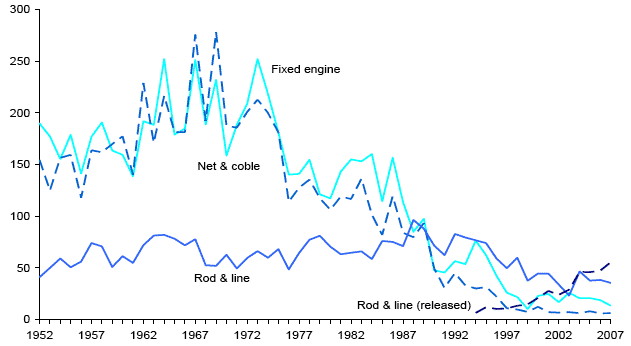Key Scottish Environment Statistics 2009
Annual publication containing summary of key statistics on environmental trends in Scotland
Biodiversity
Catches of Wild Salmon 10: 1952-2007
Numbers caught (thousands)

Number caught (thousands)
Method 11 |
1952 |
1970 |
1980 |
1990 |
2000 |
2006 |
2007 |
|---|---|---|---|---|---|---|---|
Fixed engine |
190 |
159 |
117 |
48 |
23 |
19 |
14 |
Net & coble |
154 |
187 |
106 |
50 |
13 |
6 |
6 |
Rod & line 12(retained) |
41 |
63 |
71 |
72 |
45 |
38 |
39 |
Rod & line 12(released) |
- |
- |
- |
- |
21 |
48 |
56 |
The salmon fishing industry is a significant economic and leisure resource in rural Scotland. To protect this resource sustainable management practices are essential. Climate change, water pollution, predation and disease may affect populations. Yearly variations in weather, timing of runs and fishing effort can affect catch sizes. Consequently, a difference in catch does not necessarily indicate a difference in the abundance of the stock that provides the catch.
Catch sizes for the fixed engine and net & coble fisheries have fallen by over 90% since 1952. Catches rose during the 1950s and 1960s but have declined rapidly since the early 1970s. The fishing effort has declined at a similar rate, and effort in 2007 was less than 10% of that in 1952 for both fisheries. 13
Catches by rod & line have remained relatively steady over the period 1952-2007. Since 1994, salmon that have been caught and released by anglers have been reported separately. In 2007, 39,000 salmon were retained and 56,000 released. No figures for fishing effort for rod & line catches are available.
The Salmon and Freshwater Fisheries (Consolidation) (Scotland) Act 2003 contains provisions for the conservation and sustainable management of salmon fisheries in Scotland, for example, through regulating the introduction of salmon and salmon eggs into salmon fishery districts for which there is a district salmon fishery board, and regulating the permissible methods and times during which fishing is permitted.
Source: Marine Scotland Science
There is a problem
Thanks for your feedback